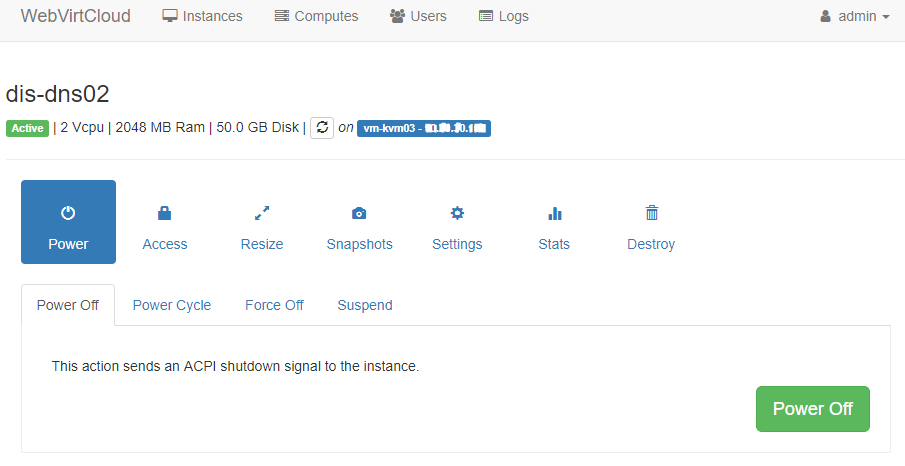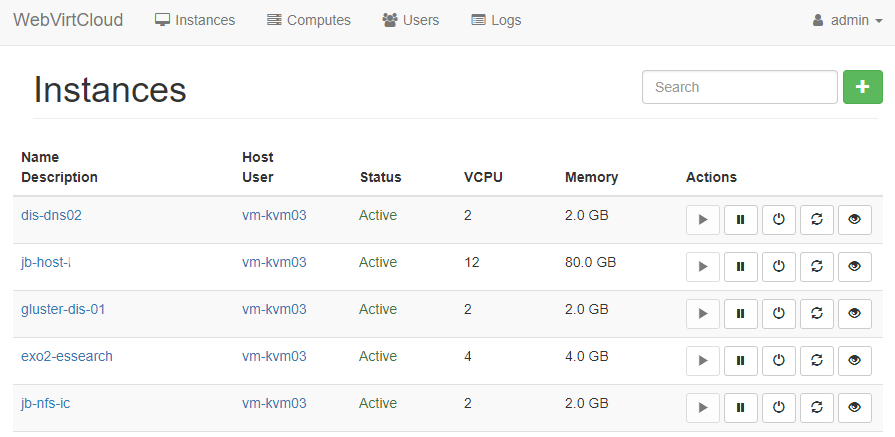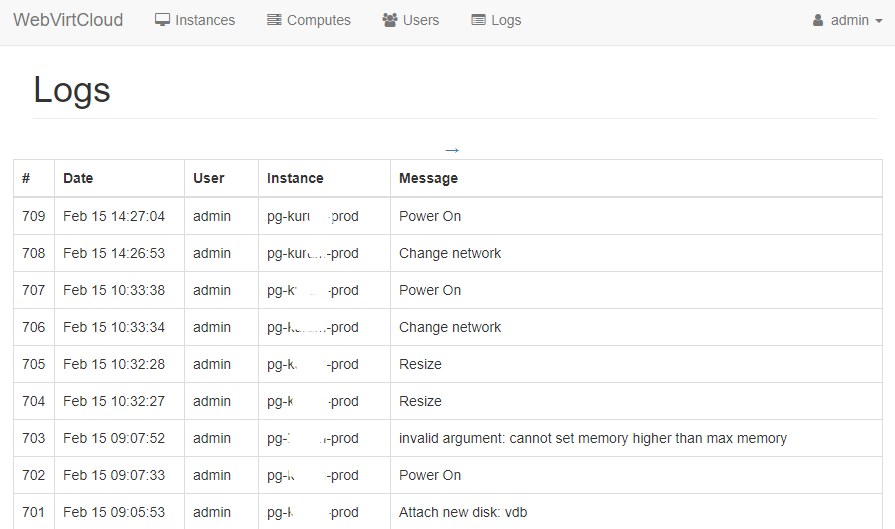7.9 KiB
WebVirtCloud
Features
- QEMU/KVM Hypervisor Management
- QEMU/KVM Instance Management - Create, Delete, Update
- Hypervisor & Instance web based stats
- Manage Multiple QEMU/KVM Hypervisor
- Manage Hypervisor Datastore pools
- Manage Hypervisor Networks
- Instance Console Access with Browsers
- Libvirt API based web management UI
- User Based Authorization and Authentication
- User can add SSH public key to root in Instance (Tested only Ubuntu)
- User can change root password in Instance (Tested only Ubuntu)
- Supports cloud-init datasource interface
Warning!!!
How to update gstfsd daemon on hypervisor:
wget -O - https://clck.ru/9VMRH | sudo tee -a /usr/local/bin/gstfsd
sudo service supervisor restart
Description
WebVirtCloud is a virtualization web interface for admins and users. It can delegate Virtual Machine's to users. A noVNC viewer presents a full graphical console to the guest domain. KVM is currently the only hypervisor supported.
Generate secret key
You should generate SECRET_KEY after cloning repo. Then put it into webvirtcloud/settings.py.
import random, string
haystack = string.ascii_letters + string.digits + string.punctuation
print(''.join([random.SystemRandom().choice(haystack) for _ in range(50)]))
Install WebVirtCloud panel (Ubuntu)
sudo apt-get -y install git virtualenv python-virtualenv python-dev python-lxml libvirt-dev zlib1g-dev libxslt1-dev nginx supervisor libsasl2-modules gcc pkg-config python-guestfs
git clone https://github.com/retspen/webvirtcloud
cd webvirtcloud
cp webvirtcloud/settings.py.template webvirtcloud/settings.py
# now put secret key to webvirtcloud/settings.py
sudo cp conf/supervisor/webvirtcloud.conf /etc/supervisor/conf.d
sudo cp conf/nginx/webvirtcloud.conf /etc/nginx/conf.d
cd ..
sudo mv webvirtcloud /srv
sudo chown -R www-data:www-data /srv/webvirtcloud
cd /srv/webvirtcloud
virtualenv venv
source venv/bin/activate
pip install -r conf/requirements.txt
python manage.py migrate
sudo chown -R www-data:www-data /srv/webvirtcloud
sudo rm /etc/nginx/sites-enabled/default
Restart services for running WebVirtCloud:
sudo service nginx restart
sudo service supervisor restart
Setup libvirt and KVM on server
wget -O - https://clck.ru/9V9fH | sudo sh
Install WebVirtCloud panel (CentOS)
sudo yum -y install python-virtualenv python-devel libvirt-devel glibc gcc nginx supervisor python-lxml git python-libguestfs iproute-tc
Creating directories and cloning repo
sudo mkdir /srv && cd /srv
sudo git clone https://github.com/retspen/webvirtcloud && cd webvirtcloud
cp webvirtcloud/settings.py.template webvirtcloud/settings.py
# now put secret key to webvirtcloud/settings.py
Start installation webvirtcloud
sudo virtualenv venv
sudo source venv/bin/activate
sudo venv/bin/pip install -r conf/requirements.txt
sudo cp conf/nginx/webvirtcloud.conf /etc/nginx/conf.d/
sudo venv/bin/python manage.py migrate
Configure the supervisor for CentOS
Add the following after the [include] line (after **files = ... ** actually):
sudo vim /etc/supervisord.conf
[program:webvirtcloud]
command=/srv/webvirtcloud/venv/bin/gunicorn webvirtcloud.wsgi:application -c /srv/webvirtcloud/gunicorn.conf.py
directory=/srv/webvirtcloud
user=nginx
autostart=true
autorestart=true
redirect_stderr=true
[program:novncd]
command=/srv/webvirtcloud/venv/bin/python /srv/webvirtcloud/console/novncd
directory=/srv/webvirtcloud
user=nginx
autostart=true
autorestart=true
redirect_stderr=true
Edit the nginx.conf file
You will need to edit the main nginx.conf file as the one that comes from the rpm's will not work. Comment the following lines:
# server {
# listen 80 default_server;
# listen [::]:80 default_server;
# server_name _;
# root /usr/share/nginx/html;
#
# # Load configuration files for the default server block.
# include /etc/nginx/default.d/*.conf;
#
# location / {
# }
#
# error_page 404 /404.html;
# location = /40x.html {
# }
#
# error_page 500 502 503 504 /50x.html;
# location = /50x.html {
# }
# }
}
Also make sure file in /etc/nginx/conf.d/webvirtcloud.conf has the proper paths:
upstream gunicorn_server {
#server unix:/srv/webvirtcloud/venv/wvcloud.socket fail_timeout=0;
server 127.0.0.1:8000 fail_timeout=0;
}
server {
listen 80;
server_name servername.domain.com;
access_log /var/log/nginx/webvirtcloud-access_log;
location /static/ {
root /srv/webvirtcloud;
expires max;
}
location / {
proxy_pass http://gunicorn_server;
proxy_set_header X-Real-IP $remote_addr;
proxy_set_header X-Forwarded-for $proxy_add_x_forwarded_for;
proxy_set_header Host $host:$server_port;
proxy_set_header X-Forwarded-Proto $remote_addr;
proxy_connect_timeout 600;
proxy_read_timeout 600;
proxy_send_timeout 600;
client_max_body_size 1024M;
}
}
Change permissions so nginx can read the webvirtcloud folder:
sudo chown -R nginx:nginx /srv/webvirtcloud
Change permission for selinux:
sudo semanage fcontext -a -t httpd_sys_content_t "/srv/webvirtcloud(/.*)"
Add required user to the kvm group:
sudo usermod -G kvm -a webvirtmgr
Let's restart nginx and the supervisord services:
sudo systemctl restart nginx && systemctl restart supervisord
And finally, check everything is running:
sudo supervisorctl status
gstfsd RUNNING pid 24662, uptime 6:01:40
novncd RUNNING pid 24661, uptime 6:01:40
webvirtcloud RUNNING pid 24660, uptime 6:01:40
Apache mod_wsgi configuration
WSGIDaemonProcess webvirtcloud threads=2 maximum-requests=1000 display-name=webvirtcloud
WSGIScriptAlias / /srv/webvirtcloud/webvirtcloud/wsgi_custom.py
Install final required packages for libvirtd and others on Host Server
wget -O - https://clck.ru/9V9fH | sudo sh
Done!!
Go to http://serverip and you should see the login screen.
Alternative running novncd via runit
Alternative to running nonvcd via supervisor is runit.
On Debian systems install runit and configure novncd service
apt install runit runit-systemd
mkdir /etc/service/novncd/
ln -s /srv/webvirtcloud/conf/runit/novncd.sh /etc/service/novncd/run
systemctl start runit.service
Default credentials
login: admin password: admin
Configuring Compute SSH connection
This is a short example of configuring cloud and compute side of the ssh connection.
On the webvirtcloud machine you need to generate ssh keys and optionally disable StrictHostKeyChecking.
chown www-data -R ~www-data
sudo -u www-data ssh-keygen
cat > ~www-data/.ssh/config << EOF
Host *
StrictHostKeyChecking no
EOF
chown www-data -R ~www-data/.ssh/config
You need to put cloud public key into authorized keys on the compute node. Simpliest way of doing this is to use ssh tool from the webvirtcloud server.
sudo -u www-data ssh-copy-id root@compute1
Cloud-init
Currently supports only root ssh authorized keys and hostname. Example configuration of the cloud-init client follows.
datasource:
OpenStack:
metadata_urls: [ "http://webvirtcloud.domain.com/datasource" ]
How To Update
sudo virtualenv venv
sudo source venv/bin/activate
git pull
pip install -U -r conf/requirements.txt
python manage.py migrate
sudo service supervisor restart
Screenshots
Instance Detail:




License
WebVirtCloud is licensed under the Apache Licence, Version 2.0.
